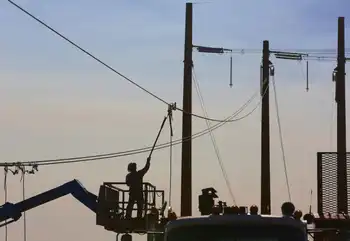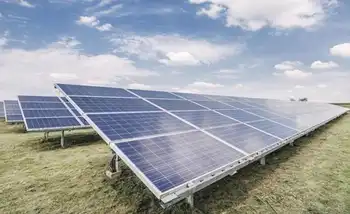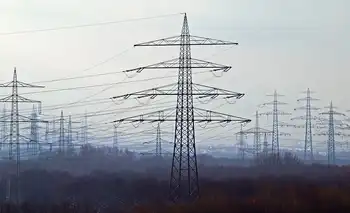Is alternative energy out of juice in Canada?
The company is not producing cells anywhere near its home in Waterloo, Ont., however; instead it is doing so in Bischofswerda, a town in eastern Germany. The transatlantic flights may not be the most pleasant experience for MacLellan, but he had little choice when it came to deciding where to locate ARISE’s first factory. “Germany is where the action is,” he says. “Canada continues to fall further and further behind in renewable energy.”
Others in the industry have similar stories. When it comes to building a renewable energy industry, Canada is simply not really a go-to destination. ThatÂ’s not to say there is no appetite domestically or that federal and provincial governments are ignoring the issue. Canada actually scores fairly high on the Ernst & Young renewable energy country attractiveness index, a ranking of nations based on the climate for clean power investment.
The most recent edition, released in August, places Canada eighth out of 25, where it has more or less remained for the past two years. “Canada could move up if it was more aggressive,” says Jonathan Johns, head of renewable energy at Ernst & Young in London. Meanwhile, Germany, Spain and the U.K. have positioned themselves as leaders by attracting investment.
Subsidies for wind and solar power are marginal in Canada, and virtually non-existent for wave, geothermal, and biomass energy. The main funding mechanism at the federal level is the ecoEnergy program, which provides a 1¢-per-kilowatt-hour subsidy for renewable energy. The initiative is set to expire in 2011 and is already close to using up its $1.48-billion budget. That’s in part driving Canadians to find more business abroad than at home.
International success is generally something to be lauded, but in this case it means Canada is missing out not only on the environmental benefits, but also on job creation and the chance to become an exporter of renewable-energy technology. “One of my frustrations is certain politicians feel that if you do what’s right for the environment, you’ll hurt the economy,” MacLellan says. “What I’m seeing first-hand is that if you do what’s right for the environment, you’ll create thousands of jobs.”
John MacDonald, co-founder of solar module manufacturer Day4 Energy in Burnaby, B.C., a fledging company that went public in a $100 million IPO last year, echoes that sentiment. “Renewable energy will be the future of energy,” he says. “There is always tons of money to be made when fundamental things change.” Canada has to make major policy changes to fully cash in.
If there is a world leader in renewable energy development, then Germany is probably close to the top of the list. The German government made a serious push for alternative energy in 2000, when it implemented the Renewable Energy Sources Act. (The German acronym is EEG.)
The program uses whatÂ’s called a feed-in tariff, a guarantee that any company producing renewable electricity can distribute it on the grid, and utilities will buy the power at a premium. The increased price allows producers to turn a profit, and the feed-in tariff is guaranteed for 20 years, ensuring a long-term market. The subsidy also decreases incrementally each year, forcing producers to increase efficiency and reduce costs.
“We did not even need to increase any taxes,” says David Wortmann of Invest in Germany, a government organization that aims to attract business to the country. Instead, the utilities pass on the price to consumers. That obviously results in higher electricity bills, but not significantly so — the average household in Germany pays an additional €2.50 for renewable power. As Wortmann puts it, “This is less than a pint of beer.” (Germans already pay about twice as much for electricity as Canadians, however.)
Solar and wind power developers have flocked to Germany largely as a result of the feed-in tariff. The photovoltaics sector alone generated €5.7 billion in revenue last year, and the country now employs about 250,000 people in alternative energy. Many of the facilities are located in eastern Germany, an area that has traditionally had high unemployment but is now experiencing a rebirth as a hub for renewable energy manufacturing.
About 15% of GermanyÂ’s electricity production is renewable (the comparable Canadian figure: 4%), and the country has ambitious goals. By 2020, it plans to boost its share of renewable electricity to 30%.
Germany isnÂ’t the only country to implement a feed-in tariff. Denmark generates about 20% of its electricity from wind, in part due to a feed-in tariff, and Spain is following GermanyÂ’s example, making an aggressive push for solar power.
Job creation may have been a significant motivator for the Germans, but they also acted out of necessity. The country is virtually devoid of natural resources, so financing ways to develop energy domestically only makes sense for its long-term security. That partly explains why Canada has been slow to move: there simply hasnÂ’t been much reason to.
The country is blessed with an abundance of natural resources — nearly 60% of its electricity is generated by hydropower. The environment is an increasing concern — but not enough to prompt the kind of action seen in Europe — and energy security is barely on the radar.
While Canada plods along, Germany is busy building an industry and attracting companies by using more than just a feed-in tariff. Invest in Germany (though not entirely focused on alternative energy) has offices around the world and actively lures companies. ThatÂ’s how ARISE Technologies ended up with a factory in Bischofswerda.
MacLellan was approached by representatives from Invest in Germany at a solar energy industry conference in 2006. “They basically said, ‘If you build your factory in Germany, we’ll give you half the money,’” MacLellan recalls. That amounted to around €24.5 million. MacLellan refers to Invest in Germany as a “one-stop shop” that provided advice, connected the company with banks, engineering and construction firms, and took him to visit approximately 20 different potential sites for the company’s factory. “They even booked my hotels and arranged my car rentals,” he says.
Locating in Germany also allowed ARISE to tap into a network of talented and experienced partners. The construction firm ARISE hired had built similar plants before, and the Canadian company would have been hard-pressed to find a plant manager with the same level of experience as the one hired in Germany. And then of course thereÂ’s the huge market in Europe.
Only 23 months elapsed between the time MacLellan was approached and when ARISE produced its first cell this past April — something that would have been next to impossible to do in Canada. “It’s not a criticism of Canada,” MacLellan points out. “If you’re building your first plant, you need to go where you can leverage off experienced people.”
Day4 Energy is having just as much success outside of Canada as ARISE. CEO John MacDonald, a co-founder and former CEO of MacDonald Dettwiler and Associates, came out of retirement to head the solar company in 2002. “We’re doing over 90% of our business in Europe,” he says. “Canada isn’t really a factor at this stage.”
And itÂ’s not just solar companies that are looking further afield, either.
Finavera Renewables, based in Vancouver, develops wind and wave energy projects. About a year and a half ago, it assessed the business opportunities in B.C. versus Oregon for developing a prototype turbine for wave energy. The company built an office in Portland, Ore., primarily because of a tax credit that allows it to recoup 33% of the costs of deploying a prototype. “The governor down there has been quite forward-thinking in terms of renewable energy. He saw the potential to build an industry,” says Myke Clark, Finavera’s senior vice-president of business development. “That’s what the tax incentive is for — to attract companies and to start developing intellectual capital.”
Geothermal companies haven’t fared much better. Although geothermal is eligible for the 1¢-per-kilowatt-hour ecoEnergy subsidy, the amount is small and does little to help companies, since the most challenging and expensive parts of building a plant are the initial exploration, drilling and construction costs. As well, a plant would have to be operational by 2011 to receive the subsidy.
“That pretty much kills any geothermal project, because there’s no way you’re going to get anything online in three years time in Canada,” says Gary Thompson, CEO of Sierra Geothermal Power in Vancouver. “We just found it very difficult to get any traction here.” Thompson says not only is the lack of incentives stalling geothermal, but the time it takes to obtain land for development is a significant factor as well. The company has submitted proposals with the B.C. government that have been sitting around for more than two years.
Sierra Geothermal is currently developing five projects, all of which are in Nevada. Up until recently, the U.S. Department of Energy funded up to 80% of exploration costs for geothermal firms. Now, the U.S. and countries such as Germany and Australia are funding research into enhanced geothermal systems, which can now be located in areas traditionally thought of as unsuitable for this form of power.
Western Geopower, also of Vancouver, is forging ahead with feasibility studies for a plant in B.C., but there are currently no such commercial projects in Canada, despite what is believed to be significant potential for geothermal power on the west coast — although just how much potential is not exactly clear, since the last time the Canadian government did any research into geothermal was in the 1980s.
A good start for Canada, Thompson says, would be for the government, along with industry, to conduct a new geothermal assessment — otherwise, Canada will fall farther behind.
“What we would miss out on is the opportunity to develop skilled jobs, and keep those jobs here,” he adds. “If the Democrats win in the U.S., you’ll see a ton of people flocking to develop projects there, which is really pulling away talent, investment and resources from here.”
What many alternative power producers say will help get the industry off the ground is a feed-in tariff similar to Germany’s. The Pembina Institute, an environmental policy think-tank based in Alberta, released a report earlier this year calling feed-in tariffs the most effective mechanism to foster renewable energy. Ontario implemented a kind of feed-in tariff in 2006, known as the Standard Offer Program, but it doesn’t go far enough for solar, according to MacDonald at Day4. “Once the investor looks at the price, it’s hard for them to see a return,” he says.
That hasnÂ’t stopped large developers from rolling in. OptiSolar, based in California, has three projects in Ontario, totaling 90 megawatts, and SkyPower out of Toronto is working on a 19-megawatt solar farm, due to be completed next year.
Still, there are improvements that can be made. MacDonald says raising the price paid for solar would be a good start, as would guaranteeing power producers access to the electricity grid. Ontario also capped the amount of power that can be generated from renewable energy under its program.
The original plan was to develop 1,000 megawatts of renewable power over 10 years, but the interest was so great the province ended up signing 1,200 megawatts of power in less than one year — a sign that producers will certainly flock to a market when the conditions are right. But now, future development under the program is currently stalled while the government reassesses how to bring on more power gradually.
Other provinces would have to implement a similar measure to fully capture the employment and environmental benefits of alternative power, of course, and there has been little interest so far. FinaveraÂ’s Clark has had informal conversations about feed-in tariffs with BC Hydro over the years, but hasnÂ’t been encouraged by the result.
“From our point of view, that’s not something that they’re willing to consider right now, given the lower cost electricity out there that’s available,” he says. MacDonald, meanwhile, says politicians may be reluctant to implement feed-in tariffs because it would be unpopular with industrial users of electricity, who would bear most of the cost.
He argues thatÂ’s necessary, however.
“People who consume the most electricity give the most support to renewable energy,” he says. “In the long run, that ultimately has to happen.”
Certainly feed-in tariffs have detractors. A German think-tank called RWI Essen released a report in March targeting the government’s promotion of the solar industry, saying it has the “potential to become a notoriously outstanding example of misguided political intervention.”
The authors’ primary concern is the amount of money put toward what they argue is among the most expensive greenhouse-gas abatement options. Germany’s support for solar tallied around €1.18 billion in 2006; the sector receives the largest subsidy of any form of power under the EEG, and yet it only made up 0.4% of the country’s electricity generation in 2007.
Since producers are guaranteed to receive the subsidy for 20 years, Germany has committed itself to funding what the authors see as an inefficient technology. Or, as the authors of the report put it, the “long dark shadows of this support will last for another two decades even if the EEG were to be abolished immediately.”
Solar is so far from cost-competitiveness that forcing it into the market at this point doesnÂ’t make sense, they argue. It would be more beneficial to invest in research and development to bring costs down.
Invest in GermanyÂ’s Wortmann says a feed-in tariff does fuel R&D, since the subsidy decreases each year, forcing companies to generate solar power more efficiently. He points out the cost of solar has been cut in half since 2000.
Canada doesnÂ’t have to adopt a feed-in tariff, however, as there are perhaps less controversial policy measures to take. For new power generation, most provinces use a competitive process. The utilities determine a certain number of megawatts of renewable energy to be developed, and invite companies to submit proposals. Utilities inevitably get more proposals than they know what to do with.
Quebec, for example, issued a call for 2,000 megawatts of wind energy, and had nearly 8,000 megawatts worth of proposals earlier this year. A company can spend millions developing a proposal, and if it doesnÂ’t win, it can be left with a lot of uncertainly about when, and even if, there will be another call for power.
“This has raised the spectre of a boom-and-bust kind of market in Canada, which is not particularly attractive to manufacturers because they’re very keen to see steady demand for their products,” says Robert Hornung, president of the Canadian Wind Energy Association. Utilities can ensure more stability for developers by announcing multiple bids over a number of years, for example — allowing developers to plan ahead.
A further complication with the Canadian market is that electricity falls under provincial jurisdiction, resulting in multiple policy frameworks. Hornung says the provinces need to start thinking outside of their borders and create agreements to buy and sell power with neighbouring regions. Not only would that be a way to essentially increase the market size, but it would also help address the irregularities of renewable energy, since solar modules and wind turbines cannot generate electricity every hour of the day.
Prince Edward Island and New Brunswick are already looking at generating renewable energy to export to the northeastern United States, an encouraging sign. “There are a bunch of challenges in doing that, transmission being one of them,” Hornung says. “But we’re starting to see the first discussions to address those challenges.”
Simply creating a market isnÂ’t enough to attract manufacturers these days, though.
Hornung says that’s just a miimum requirement. Other regions are aggressive at courting manufacturers. Iowa has been one of the most successful American states when it comes to wind turbine manufacturing, and that’s in part because its governor, Chet Culver, a Democrat, makes jaunts to Europe to visit with companies and encourage them to build in the state. “We have to recognize that it isn’t just going to happen just because we’re building wind projects here,” Hornung says.
There are a few positive signs in Canada. Quebec required a percentage of material to be produced locally when it issued its call for wind power, and Ontario set up its Next Generation of Jobs Fund last year, in which “green” jobs are a priority.
Regional governments are getting involved, too. Windsor, Essex and Chatham-Kent in southern Ontario launched the Green Collar Jobs Coalition to attract renewable energy companies in July, hoping to breathe new life into the manufacturing industry. Such work is proceeding slowly, however.
“We’re coming somewhat late to the game,” admits David Timm, one of the co-founders of the coalition. In wind power, Canada has just a handful of manufacturers,whereas the U.S. has announced 41 new turbine facilities or expansions and 9,000 new jobs since January 2007.
ARISE’s MacLellan thinks Canada is well-suited for renewable energy development. He points to the country’s significant wind resources, and says Ontario actually gets more sun than Germany, making it a better location for solar. “I kind of view Ontario as the glass being half full,” he says, “and the good news is they’re interested in having a full glass.”
Even so, MacLellan is not fully committed to building a manufacturing plant in Canada just yet.
ARISE is in the process of deciding where to build its second manufacturing facility, and the top two choices are Germany and Ontario. But MacLellan also says he’s been approached by representatives from several other countries — an indication of just how competitive the sector is.
“What I find amazing is the interest there is in building our next plant,” he says. “Invariably people tell us, ‘We can match what they do in Germany.’”
Related News

Cost, safety drive line-burying decisions at Tucson Electric Power
TUCSON - Though wildfires in California caused by power lines have prompted calls for more underground lines, Tucson Electric Power Co. plans to keep to its policy of burying lines selectively for safety.
Like many other utilities, TEP typically doesn’t install its long-range, high-voltage transmission lines and distribution equipment underground because of higher costs that would be passed on to ratepayers, TEP spokesman Joe Barrios said.
But the company will sometimes bury lower-voltage lines and equipment where it is cost-effective or needed for safety, or if customers or developers are willing to pay the higher installation costs
Underground installations generally include additional engineering…





